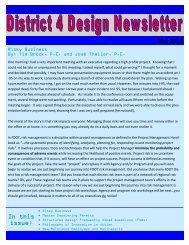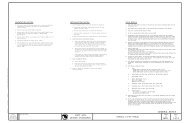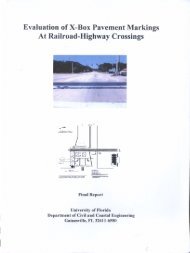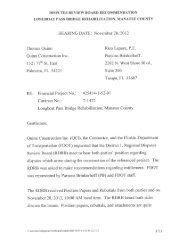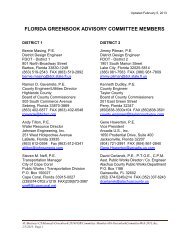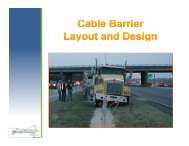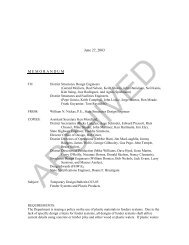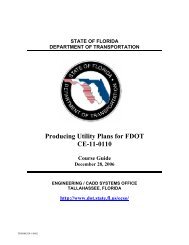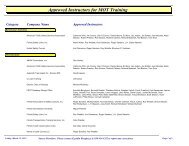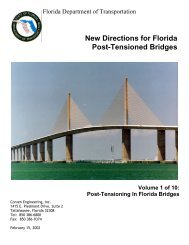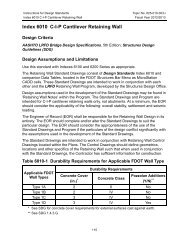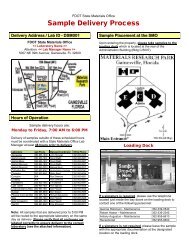Improving the Properbes of Reclaimed Asphalt Pavement for ...
Improving the Properbes of Reclaimed Asphalt Pavement for ...
Improving the Properbes of Reclaimed Asphalt Pavement for ...
You also want an ePaper? Increase the reach of your titles
YUMPU automatically turns print PDFs into web optimized ePapers that Google loves.
<strong>Improving</strong> <strong>the</strong> Proper/es <strong>of</strong><br />
<strong>Reclaimed</strong> <strong>Asphalt</strong> <strong>Pavement</strong> <strong>for</strong><br />
Roadway Base Applica/ons Final<br />
Report<br />
David Horhota, Ph.D., P.E. PM<br />
Paul Cosen/no, Ph.D., P.E. PI<br />
Edward Kalajian, Ph.D., P.E. PI<br />
Albert Bleakley Ph.D., P.E.<br />
Babacar Diouf<br />
Ryan Krajcik<br />
August 16, 2012<br />
Thaddeus Misilo III<br />
Andrew Petersen<br />
Amir Mohammad Sajjadi
Problem Statement<br />
! FDOT specifica/ons only allow RAP to be reused as a<br />
base in non-‐trafficked areas<br />
! Florida’s Aggregate produc/on does not meet needs<br />
! Aggregates are hauled in from as far away as Central<br />
America and Nova Sco/a<br />
! 10 mile I-‐95 widening project Brevard County<br />
! reusing RAP in base would save 40,000 tons <strong>of</strong> material<br />
! $800,000 -‐ $1,000,000 es/mated savings
Problem Statement<br />
! Two problems limit RAP use:<br />
! Low strength<br />
! Creep de<strong>for</strong>ma/on<br />
! FDOT specifica/ons use <strong>the</strong> Limerock Bearing<br />
Ra/o (LBR) strength<br />
! Required LBR is 100 (800 psi) <strong>for</strong> base material<br />
! RAP LBR typically between 10 & 30<br />
! RAP creep leads to ru`ng
Outline<br />
! Objec/ve<br />
! Tasks<br />
! Results<br />
! Frac/ona/ng<br />
! Compac/on<br />
! Blending<br />
! Chemical Stabiliza/on<br />
! Conclusions &Recommenda/ons<br />
! Ques/ons
Objec/ve<br />
v Develop engineering methods to improve<br />
bearing ra/os while reducing creep<br />
v Leads to increased use <strong>of</strong> RAP as a base<br />
course.
Tasks<br />
! Task 1 – Literature Review<br />
! Task 2 – Tes/ng Program Development<br />
! Task 3 – Grada/on Modifica/on (Frac/ona/ng)<br />
! Task 4 – Blends with High Quality Base<br />
! Task 5 – <strong>Asphalt</strong> Content Evalua/ons<br />
! Task 6 – Compac/on Improvements Using<br />
! Mechanical Energy<br />
! Chemical Admixtures
Literature Review Focus<br />
! General Characteris/cs <strong>of</strong> RAP<br />
! Current use <strong>of</strong> RAP or RAP blends as base<br />
! Compac/on <strong>of</strong> RAP or RAP/aggregate blends<br />
! Blending <strong>of</strong> RAP and virgin aggregates<br />
! Use <strong>of</strong> chemical stabilizing addi/ves with RAP<br />
including Cold In-‐place Recycling (CIR) or Full<br />
Depth Reclama/on (FDR) pavement restora/on<br />
! Creep behavior <strong>of</strong> soils and RAP<br />
! Ma<strong>the</strong>ma/cal modeling <strong>of</strong> <strong>the</strong> rheological<br />
response <strong>of</strong> viscoelas/c materials to stress
Rela/ve Effects <strong>of</strong> increasing RAP<br />
content<br />
Reference Blends Dry Density Permeability CBR<br />
! McGarrah (2007) literature summary<br />
Resilient<br />
Modulus<br />
Cooley (2005) Yes Decreased -‐-‐-‐ Decreased -‐-‐-‐<br />
Garg & Thompson (1996) No Decreased -‐-‐-‐ Decreased -‐-‐-‐<br />
MacGregor (1999) Yes -‐-‐-‐ No Change -‐-‐-‐ Increased<br />
Bennert & Maher (2005) Yes Decreased Decreased -‐-‐-‐ Increased<br />
Papp (1998) Yes Decreased -‐-‐-‐ -‐-‐-‐ Increased<br />
Sayed (1993) No -‐-‐-‐ -‐-‐-‐ Decreased -‐-‐-‐<br />
Taha (1999) Yes Decreased Increased Decreased -‐-‐-‐<br />
Trzebiatowski (2005) No Decreased Increased -‐-‐-‐ -‐-‐-‐
Current RAP Specifica/ons<br />
! McGarrah<br />
(2007)<br />
Summary <strong>of</strong><br />
state<br />
prac/ces<br />
State<br />
RAP<br />
Allowed<br />
Max % Processed Tes4ng<br />
Florida No -‐-‐-‐ -‐-‐-‐ -‐-‐-‐<br />
Illinois No -‐-‐-‐ -‐-‐-‐ -‐-‐-‐<br />
Montana Yes 50-‐60% No<br />
Corrected Nuc<br />
Gauge<br />
New Jersey Yes 50% 5 Yes<br />
Grada/on<br />
Corrected Nuc<br />
Gauge + Sample<br />
Minnesota Yes 3% 6 Yes<br />
Grada/on<br />
Dynamic Cone<br />
Penetrometer<br />
Colorado Yes 50% 5 Yes Max<br />
Agg. Size<br />
Roller Compac/on<br />
Strip<br />
Utah Yes 2% 6 Yes<br />
Grada/on<br />
Nuc Gauge or<br />
Breakdown Curve<br />
Texas7 Yes 20% Unknown<br />
Various (Including<br />
Nuc Gauge)<br />
Cali<strong>for</strong>nia7 Yes 50% Unknown<br />
No special tes/ng<br />
procedure listed<br />
New<br />
Mexico7 Yes Unknown Unknown<br />
Corrected Nuc<br />
Gauge<br />
Rhode<br />
Island7 Yes Unknown<br />
Yes<br />
Grada/on<br />
Unknown<br />
South<br />
Dakota7 No -‐-‐-‐ -‐-‐-‐ -‐-‐-‐
Creep Theory <strong>for</strong> Soils<br />
Singh and Mitchell (1968) developed a model to<br />
m<br />
describe creep <strong>of</strong> clays.<br />
αD<br />
⎛⎛ t1<br />
⎞⎞<br />
> 90 % failure<br />
30 to 90 % failure<br />
< 30 % failure<br />
ε = Ae ⎜⎜ ⎟⎟<br />
⎝⎝ t ⎠⎠<br />
A – log strain rate vs. deviator<br />
stress and finding <strong>the</strong><br />
intercept when D = 0.<br />
m – slope <strong>of</strong> log strain versus<br />
log /me straight line.<br />
D – deviator stress<br />
α – slope <strong>of</strong> <strong>the</strong> linear por/on<br />
<strong>of</strong> <strong>the</strong> logarithm strain versus<br />
deviator-‐stress plot.<br />
t 1 – reference /me (1 day)<br />
t – /me
Creep Compliance (%/psi)<br />
0.18<br />
0.16<br />
0.14<br />
0.12<br />
0.1<br />
0.08<br />
0.06<br />
0.04<br />
0.02<br />
Background and Theory<br />
Creep Behavior <strong>of</strong> RAP/A-‐3 Blends<br />
RAP100-B6<br />
RAP100-B12<br />
RAP100-B24<br />
RAP80-B6<br />
RAP80-B12<br />
RAP80-B24<br />
RAP60-B6<br />
RAP60-B12<br />
RAP60-B24<br />
A3-B6<br />
A3-B12<br />
A3-B24<br />
Creep Compliance (%/psi)<br />
0<br />
0<br />
0 1 2 3 4<br />
Time (days)<br />
5 6 7<br />
0.0001 0.001 0.01 0.1<br />
Log Time (days) (days)<br />
1 10<br />
0.18<br />
0.16<br />
0.14<br />
0.12<br />
0.1<br />
0.08<br />
0.06<br />
0.04<br />
0.02<br />
RAP100-B6<br />
RAP100-B12<br />
RAP100-B24<br />
RAP80-B6<br />
RAP80-B12<br />
RAP80-B24<br />
RAP60-B6<br />
RAP60-B12<br />
RAP60-B24<br />
A3-B6<br />
A3-B12<br />
A3-B24<br />
Cleary (2005) and Dikova (2006)<br />
80% RAP/20% A-‐3 Sand<br />
100 % RAP
Laboratory Inves/ga/on Program<br />
! Test types<br />
! Index tests to describe <strong>the</strong> material<br />
! Strength tests to determine load capacity<br />
! Creep tests to determine suscep/bility to long-‐term<br />
de<strong>for</strong>ma/on<br />
! Test materials<br />
! RAP, A-‐3 sand, limerock, cemented coquina, and<br />
crushed concrete base (FDOT spec)<br />
! 100% RAP, blends <strong>of</strong> RAP/aggregate base material<br />
containing 75%, 50%, and 25% RAP, and 100%<br />
aggregate base<br />
! 0%, 1%, 2%, and 3% stabilizing agent (asphalt<br />
emulsion, Portland cement or lime) by weight
Laboratory<br />
Tes/ng Example<br />
Soaked<br />
Marshall<br />
Compaction<br />
Curing<br />
Marshall<br />
Compression<br />
Testing<br />
Unsoaked<br />
Blending<br />
Anionic<br />
Emulsion<br />
6 in Mod<br />
Proctor<br />
Compaction<br />
Curing<br />
One<br />
Dimensional<br />
Creep<br />
Unsoaked<br />
LBR Testing<br />
Sampling<br />
Air Drying<br />
Crushing<br />
Blending<br />
Cationic<br />
Emulsion<br />
Mod<br />
Proctor<br />
Compaction<br />
Soaked<br />
Data<br />
Analysis<br />
Blending<br />
Portland<br />
Cement<br />
Curing<br />
Indirect<br />
Tensile<br />
Testing<br />
Gyratory<br />
Compaction<br />
Unsoaked<br />
Soaked<br />
4x8 Mod<br />
Proctor<br />
Compaction<br />
Curing<br />
Unconfined<br />
Compression<br />
Testing<br />
Unsoaked
Loca/ons<br />
! Sampling<br />
! Drying<br />
! Sample reduc/on<br />
! Oversize material<br />
Whitehurst Gainesville<br />
APAC Jacksonville<br />
14<br />
APAC Melbourne
Stabilizing Agents
Blending
Compac/on
Curing
Soaking
Creep Test
LBR Test
Marshall<br />
Test
Unconfined<br />
Compression Test
Indirect Tensile Test
RAP Index Proper/es<br />
Properties APAC -<br />
Melbourne<br />
APAC -<br />
Melbourne<br />
Whitehurst-<br />
Gainesville<br />
APAC -<br />
Jacksonville<br />
Milled Crushed Milled Crushed<br />
Passing #4 (%) 58.1 75.8 46.0 73.38<br />
Passing #8 (%) 32.8 50 42.0 55.27<br />
Passing #40 (%) 7.68 14.35 11.0 33.33<br />
Passing #200 (%) 0.50 0.60 0.30 6.82<br />
C u 9.80 10.7 12.0 28.0<br />
C c 1.73 0.94 0.88 0.32<br />
AASHTO A-1-a A-1-a A-1-a A-1-b<br />
USCS SW SW SW SW
Percent Finer (%)<br />
100%<br />
90%<br />
80%<br />
70%<br />
60%<br />
50%<br />
40%<br />
30%<br />
20%<br />
10%<br />
0%<br />
100<br />
Sieve Analysis<br />
Grain Size Distribution Curve<br />
10<br />
1<br />
Sieve Opening (mm)<br />
100% MMRAP<br />
75% MMRAP<br />
50% MMRAP<br />
25% MMRAP<br />
100% LR<br />
FDOT Max<br />
FDOT Min<br />
0.1<br />
0.01
%<br />
RAP<br />
Milled<br />
Melb.<br />
RAP/<br />
Limerock<br />
Milled<br />
Melb.<br />
RAP/<br />
Cemented<br />
Coquina<br />
Permeability<br />
Milled<br />
Melb.<br />
RAP/<br />
Crushed<br />
Concrete<br />
Permeability (cm/s)<br />
Crushed<br />
Jax.<br />
RAP/<br />
Limerock<br />
Crushed<br />
Jax. RAP/<br />
Cemented<br />
Coquina<br />
Milled<br />
W.H.<br />
RAP/<br />
Limerock<br />
Milled<br />
W.H. RAP/<br />
Cemented<br />
Coquina<br />
100 3.1E-‐03 3.1E-‐03 3.1E-‐03 1.8E-‐05 1.8E-‐05 1.3E-‐04 1.3E-‐04<br />
50 3.2E-‐04 1.8E-‐05 1.2E-‐04 2.1E-‐05 5.5E-‐05 8.3E-‐05 3.6E-‐05<br />
25 3.2E-‐05 5.9E-‐06 1.4E-‐04 4.2E-‐06 5.4E-‐04 1.2E-‐06 2.7E-‐04<br />
0<br />
1.2E-‐06 3.0E-‐06 2.9E-‐05 1.2E-‐06 3.0E-‐06 1.2E-‐06 3.0E-‐06
Frac/ona/ng or Grada/on Modifica/on<br />
Thesis by: Babacar Diouf<br />
! 100% RAP<br />
! 2 sources <strong>for</strong> each crushed and milled RAP<br />
! Specimens <strong>of</strong> +/-‐ #4,#8,#40 and Talbot curve<br />
mixes<br />
! Creep and post creep LBR on each specimen
Results-‐Creep Tests<br />
Crushed APAC Melbourne<br />
Milled APAC Melbourne
Results-‐Post Creep LBR<br />
Crushed APAC Melbourne<br />
Milled APAC Melbourne
! RAP Frac/ons<br />
had lower LBR<br />
than non-‐<br />
frac/onated<br />
RAP<br />
! Talbot blends<br />
(i.e. maximum<br />
density)<br />
improved LBR<br />
Post Creep LBR Comparisons
Compac/on Methods<br />
Thesis by: Andrew Petersen<br />
! Vibratory<br />
! Gyratory<br />
! Modified Proctor<br />
! Combina/on <strong>of</strong> Methods
LBR – Vibratory Compac/on<br />
! Weak linear increase<br />
in LBR as dry density<br />
increased<br />
! Approximate LBR<br />
increase 0.24 per 1<br />
pcf dry density<br />
! Maximum value <strong>of</strong><br />
21 below FDOT<br />
specifica/on<br />
! Lower densi/es than<br />
mod Proctor or<br />
gyratory
Unsoaked LBR<br />
120<br />
100<br />
80<br />
60<br />
40<br />
20<br />
Modified Proctor – Gyratory Comparison:<br />
LBR<br />
Gyratory<br />
y = 2.65x - 245.63<br />
R² = 0.58<br />
Modified Proctor<br />
y = 0.58x - 51.28<br />
R² = 0.45<br />
0<br />
100 105 110 115 120 125 130 135<br />
Dry Density (pcf)<br />
FIT Gyratory FIT Mod. Proctor FDOT Gyratory FDOT Mod Proctor<br />
! Linear increase in<br />
LBR as dry density<br />
increased<br />
! Gyratory<br />
compacted<br />
specimens 2 -‐ 4<br />
/mes higher LBR<br />
than mod Proctor<br />
! Some unsoaked<br />
LBR over 100
Modified Proctor – Gyratory Comparison:<br />
Unconfined Compression (UCC)<br />
! Gyratory resulted<br />
in 2 to 3 /mes<br />
higher unconfined<br />
compressive<br />
strength than<br />
modified Proctor
Modified Proctor – Gyratory Comparison:<br />
Indirect Tensile Test<br />
! Gyratory resulted<br />
in 2 to 3 /mes<br />
higher indirect<br />
tensile strength<br />
than modified<br />
Proctor
Follow-‐on Proctor-‐Gyratory<br />
Comparison<br />
! Indirect Tensile and LBR tes/ng <strong>of</strong> three<br />
aggregate materials without asphalt binder<br />
! Limerock base<br />
! Cemented coquina<br />
! Clayey sand
Average Gyratory/Proctor Strength<br />
Ra/os
Displacement (in)<br />
0.06<br />
0.05<br />
0.04<br />
0.03<br />
0.02<br />
0.01<br />
Gyratory – Proctor Unconfined Creep<br />
0<br />
0.01 0.10 1.00<br />
Log Time (days)<br />
100% RAP<br />
Average Proctor 100% LR no stab Average Gyratory 100% LR no stab<br />
! Ini/ally similar<br />
creep<br />
! Proctor<br />
specimen in<br />
ter/ary creep
Displacement (in)<br />
0.009<br />
0.008<br />
0.007<br />
0.006<br />
0.005<br />
0.004<br />
0.003<br />
0.002<br />
0.001<br />
Gyratory – Proctor Unconfined Creep<br />
100% Limerock<br />
y = 0.0002ln(x) + 0.0069<br />
y = 0.0002ln(x) + 0.0011<br />
0<br />
0.01 0.10 1.00<br />
Log Time (days)<br />
Average Proctor 100% LR no stab Average Gyratory 100% LR no stab<br />
! Gyratory –<br />
Proctor same<br />
CSR<br />
! No ter/ary<br />
creep
Displacement (in)<br />
0.014<br />
0.012<br />
0.01<br />
0.008<br />
0.006<br />
0.004<br />
0.002<br />
Gyratory – Proctor Unconfined Creep<br />
50% RAP/ 50% Limerock<br />
y = 0.0005ln(x) + 0.0098<br />
y = 0.0004ln(x) + 0.0076<br />
0<br />
0.01 0.10 1.00<br />
Log Time (days)<br />
10.00<br />
Average Proctor 50% LR no stab Average Gyratory 50% LR no stab<br />
! Gyratory –<br />
Proctor similar<br />
CSR<br />
! No ter/ary<br />
creep
Displacement (in)<br />
0.04<br />
0.035<br />
0.03<br />
0.025<br />
0.02<br />
0.015<br />
0.01<br />
Gyratory Unconfined Creep<br />
Summary<br />
0.005<br />
100% Limerock<br />
0<br />
0.01 0.1 1 10<br />
Log Time (days)<br />
100% MRAP<br />
50% MRAP/50% Limerock<br />
! 50%/50%<br />
blend creep<br />
similar to<br />
100% LR<br />
! No ter/ary<br />
creep<br />
! Proctor similar<br />
results (not<br />
shown)
Displacement (in)<br />
0.014<br />
0.012<br />
0.01<br />
0.008<br />
0.006<br />
0.004<br />
0.002<br />
Unload/reload effect on creep<br />
y = 0.0005ln(x) + 0.0109<br />
y = 0.0003ln(x) + 0.0063<br />
0<br />
1.00<br />
Time (days)<br />
10.00<br />
Average Proctor 50% LR no stab Average Gyratory 50% LR no stab<br />
! Both gyratory and<br />
modified Proctor<br />
compacted<br />
specimens<br />
rebounded 20%<br />
when unloaded<br />
! Arer reload,<br />
creep con/nued<br />
at same rate
Task 4 – Blending RAP with High<br />
Quality Materials<br />
Thaddeus (TJ) Misilo
Blends with High Quality Materials<br />
! Milled RAP<br />
! Select Base Materials<br />
! Limerock<br />
! Cemented Coquina<br />
! Recycled Concrete<br />
! Different Blend Combina/ons<br />
! 100% -‐ 0%<br />
! 75% -‐ 25%<br />
! 50% -‐ 50%<br />
! 25% -‐ 75%<br />
! Same tests as frac/onated samples
Dry Density [lb/ft 3 ]<br />
132<br />
130<br />
128<br />
126<br />
124<br />
122<br />
120<br />
118<br />
116<br />
Typical Dry Density and LBR<br />
vs. Moisture Content Plots<br />
100% Cemented Coquina<br />
75/25% CCB / MMRAP<br />
50/50% CCB / MMRAP<br />
25/75% CB / MMRAP<br />
114<br />
2 4 6 8<br />
Moisture Content [%]<br />
10 12 14<br />
LBR<br />
10 3<br />
10 2<br />
10 1<br />
100% Cemented Coquina<br />
75/25% CCB / MMRAP<br />
50/50% CCB / MMRAP<br />
25/75% CCB / MMRAP<br />
2 4 6 8<br />
Moisture Content [%]<br />
10 12 14
CCR [in/in/psi/day]<br />
Cemented Coquina Blends<br />
CCR vs. Creep Loading Pressure<br />
10 -3<br />
10 -4<br />
10 -5<br />
10 -6<br />
10 -7<br />
10 1<br />
100% Cemented Coquina<br />
75/25% CCB/MMRAP<br />
50/50% CCB/MMRAP<br />
25/75% CCB/MMRAP<br />
Creep Loading Pressure [psi]<br />
10 2
Strain [in/in]<br />
0.04<br />
0.035<br />
0.03<br />
0.025<br />
0.02<br />
0.015<br />
0.01<br />
0.005<br />
10 -3<br />
100% Limerock - Mold 53<br />
Creep Test Results Limerock<br />
100% Limerock - Mold 55<br />
75/25% LR/MMRAP - Mold 32<br />
75/25% LR/MMRAP - Mold 38<br />
50/50% LR/MMRAP - Mold 52<br />
50/50% LR/MMRAP - Mold 53<br />
25/75% LR/MMRAP - Mold 36<br />
25/75% LR/MMRAP - Mold 49<br />
10 -2<br />
100 psi vs. Log Time<br />
10 -1<br />
Time [days]<br />
10 0<br />
10 1<br />
10 2
Unsoaked LBR<br />
10 3<br />
10 2<br />
10 1<br />
Blend Summary<br />
Unsoaked LBR vs.<br />
% Milled Melbourne RAP<br />
Limerock<br />
Cemented Coquina<br />
Recycled Concrete<br />
0 10 20 30 40 50 60 70 80 90 100<br />
Milled Melbourne RAP [%]
Effect <strong>of</strong> Blending on LBR and Creep<br />
Description<br />
Unsoaked<br />
LBR<br />
Acceptable Soaked<br />
LBR<br />
Acceptable<br />
30 Year<br />
De<strong>for</strong>mation Acceptable<br />
10 in base, 25 psi<br />
Limerock MRAP<br />
100 0 180 Yes 162 Yes 0.08 Yes<br />
75 25 225 Yes 99 No 0.12 Yes<br />
50 50 82 No 55 No 0.15 Yes<br />
25 75 43 No NP No 0.28 Yes<br />
0 100 31 No NP No 0.56 No<br />
Cemented Coquina MRAP<br />
100 0 216 Yes 63 No 0.07 Yes<br />
75 25 150 Yes 93 No 0.08 Yes<br />
50 50 79 No NP No 0.17 Yes<br />
25 75 40 No NP No 0.44 No<br />
0 100 31 No NP No 0.56 No<br />
Recycled <strong>Reclaimed</strong> Concrete Concrete<br />
Aggragate MRAP<br />
100 0 159 Yes 162 Yes 0.07 Yes<br />
75 25 76 No NP No 0.08 Yes<br />
50 50 48 No NP No 0.13 Yes<br />
25 75 30 No NP No 0.43 No<br />
0 100 31 No NP No 0.56 No<br />
NP -‐ Soaked LBR test not per<strong>for</strong>med since Unsoaked LBR was below 100
Task 6b – Compac/on Improvements<br />
Using Chemical Admixtures<br />
Albert Bleakley
Unsoaked LBR vs RAP Content<br />
Unsoaked LBR (no units)<br />
300<br />
250<br />
200<br />
150<br />
100<br />
50<br />
0<br />
0% 25% 50% 75% 100%<br />
RAP Content (%)<br />
100% MRAP 75% MRAP/ 25% LR 60% MRAP/ 40% LR 55% MRAP/ 45% LR<br />
50% MRAP/ 50% LR 25% MRAP/ 75% LR 100% LR<br />
y = -213.31x + 206.5<br />
R² = 0.849
Creep Strain Rate vs RAP Content<br />
Creep Strain Rate (in/in/log(t))<br />
3.00E-03<br />
2.50E-03<br />
2.00E-03<br />
1.50E-03<br />
1.00E-03<br />
5.00E-04<br />
y = 0.0026x + 4E-05<br />
R² = 0.718<br />
0.00E+00<br />
0% 25% 50% 75% 100%<br />
RAP Content (%)<br />
100% MRAP 75% MRAP/ 25% LR 60% MRAP/ 40% LR<br />
55% MRAP/ 45% LR 50% MRAP/ 50% LR 25% MRAP/ 75% LR<br />
100% LR
Unsoaked LBR (no units)<br />
600.0<br />
500.0<br />
400.0<br />
300.0<br />
200.0<br />
100.0<br />
CSS-‐1H Stabilized MRAP/Limerock Blends<br />
0.0<br />
0.0% 0.5% 1.0% 1.5% 2.0% 2.5% 3.0%<br />
% CSS-1H<br />
100% MRAP 75% MRAP/25% LR<br />
50% MRAP/50% LR<br />
100% LR<br />
25% MRAP/75% LR<br />
0.0035<br />
0.0030<br />
0.0025<br />
0.0020<br />
0.0015<br />
0.0010<br />
0.0005<br />
0.0000<br />
0.0% 1.0% 2.0%<br />
% CSS-1H<br />
3.0%<br />
100% MRAP<br />
50% MRAP/50% LR<br />
100% LR<br />
75% MRAP/25% LR<br />
25% MRAP/75% LR<br />
! Large LBR improvement from blending (6x – 12x)<br />
! 10% -‐ 20% LBR improvement from 1% CSS-‐1H<br />
! Large creep reduc/on from blending (.7x -‐ .1x)<br />
! 10% -‐ 20% creep improvement from 1% CSS-‐1H<br />
Creep Strain Rate (Δstrain/Δlog time)
Unsoaked LBR (no units)<br />
SS-‐1H stabilized MRAP/limerock (48 hr oven)<br />
600.0<br />
500.0<br />
400.0<br />
300.0<br />
200.0<br />
100.0<br />
0.0<br />
0.0% 0.5% 1.0% 1.5%<br />
% SS-1H<br />
2.0% 2.5% 3.0%<br />
100% MRAP 75% MRAP/25% LR<br />
50% MRAP/50% LR 25% MRAP/75%LR<br />
100% LR<br />
0.0035<br />
0.0030<br />
0.0025<br />
0.0020<br />
0.0015<br />
0.0010<br />
0.0005<br />
0.0000<br />
0.0% 1.0% 2.0%<br />
% SS-1H<br />
3.0%<br />
! Large LBR improvement from blending (1.5x – 4x)<br />
! 10% -‐ 20% LBR improvement from 1% SS-‐1H<br />
! Large creep reduc/on from blending (.7x -‐ .1x)<br />
! Mixed creep improvement from 1% SS-‐1H<br />
Creep Strain Rate (Δstrain/Δlog time)<br />
100% MRAP 75% MRAP/25% LR<br />
50% MRAP/50% LR 25% MRAP/75% LR<br />
100% LR
Unsoaked LBR (no units)<br />
Cement Stabilized MRAP/Limerock Blends<br />
800<br />
700<br />
600<br />
500<br />
400<br />
300<br />
200<br />
100<br />
0<br />
0.0% 1.0%<br />
% Cement<br />
2.0% 3.0%<br />
100% MRAP 75% MRAP/25% LR<br />
50% MRAP/50% LR 25% MRAP/75% LR<br />
100% LR<br />
0.0035<br />
0.0030<br />
0.0025<br />
0.0020<br />
0.0015<br />
0.0010<br />
0.0005<br />
0.0000<br />
0.0% 1.0% 2.0%<br />
% Cement<br />
3.0%<br />
! Large LBR improvement from blending (1.5x – 4x)<br />
! 20% -‐ 40% LBR improvement from 1% cement<br />
! Large creep reduc/on from blending (.7x – .1x)<br />
! 30% -‐ 90% creep reduc/on from 1% cement<br />
Creep Strain Rate (Δstrain/Δlog time)<br />
100% MRAP 75% MRAP/25% LR<br />
50% MRAP/50% LR 25% MRAP/75% LR<br />
100% LR
Unsoaked LBR (no units)<br />
800<br />
700<br />
600<br />
500<br />
400<br />
300<br />
200<br />
100<br />
Summary <strong>of</strong> Stabilized 50% RAP/LR<br />
0<br />
0.0% 1.0% 2.0% 3.0%<br />
% Stabilizing Agent<br />
SS-1H CSS-1H PC<br />
Blends<br />
0.0025<br />
0.0020<br />
0.0015<br />
0.0010<br />
0.0005<br />
! Large LBR improvement from blending<br />
0.0000<br />
0.0% 1.0% 2.0% 3.0%<br />
! Emulsions show LBR peak at 1%; cement does not<br />
! Emulsions show mixed creep results at 1%; cement<br />
decreases creep<br />
Creep Strain Rate (Δstrain/Δlog time)<br />
% Stabilizing Agent<br />
SS-1H CSS-1H PC
Unsoaked Compressive Stress (psi)<br />
Unconfined Compression Blends with CSS-‐1H<br />
300<br />
250<br />
200<br />
150<br />
100<br />
50<br />
Unsoaked<br />
0<br />
0% 1% % CSS-1HF 2% 3%<br />
75% MRAP/25% LR 50% MRAP/50% LR<br />
25% MRAP/75% LR 100% MRAP<br />
100% LR<br />
0<br />
0% 1% 2%<br />
% CSS-1HF<br />
3%<br />
! Blending increased UCC strength 10% -‐ 90%<br />
! UCC strength increased 2.5x – 3.5x with 1% CSS-‐1H<br />
! Blending decreased peak displacement 10% -‐ 40%<br />
! Peak displacement increased with CSS-‐1H content<br />
Soaked Compressive Stress (psi)<br />
300<br />
250<br />
200<br />
150<br />
100<br />
50<br />
Soaked<br />
75% MRAP/25% LR 50% MRAP/50% LR<br />
25% MRAP/75% LR 100% MRAP<br />
100% LR
Unsoaked Strength (psi)<br />
Unconfined Compression Blends with CSS-‐1H<br />
300<br />
250<br />
200<br />
150<br />
100<br />
50<br />
0<br />
Unsoaked LR<br />
0% 1% 2% 3%<br />
% SS-1H<br />
100% MRAP 75% MRAP/25% LR<br />
50% MRAP/50% LR 25% MRAP/75% LR<br />
100% LR<br />
Soaked Strength (psi)<br />
300<br />
250<br />
200<br />
150<br />
100<br />
50<br />
0<br />
Unsoaked LR<br />
0% 1% 2% 3%<br />
% SS-1H<br />
100% MRAP 75% MRAP/25% LR<br />
50% MRAP/50% LR 25% MRAP/75% LR<br />
100% LR
Unsoaked Compressive Stress (psi)<br />
Unconfined Compression Blends with SS-‐1H<br />
300<br />
250<br />
200<br />
150<br />
100<br />
50<br />
Unsoaked<br />
0<br />
0% 1%<br />
% SS-1H<br />
2% 3%<br />
100% MRAP 75% MRAP/25% LR<br />
50% MRAP/50% LR 25% MRAP/75% LR<br />
100% LR<br />
Soaked Compressive Stress<br />
(psi)<br />
0<br />
0% 1%<br />
% SS-1H<br />
2% 3%<br />
! Blending increased UCC strength 10% -‐ 90%<br />
! UCC strength increased 1.1x -‐ 4x with 1% SS-‐1H<br />
! Blending decreased peak displacement 0% -‐ 30%<br />
! Peak displacement increased with SS-‐1H content<br />
300<br />
250<br />
200<br />
150<br />
100<br />
50<br />
Soaked<br />
100% MRAP 75% MRAP/25% LR<br />
50% MRAP/50% LR 25% MRAP/75% LR<br />
100% LR
Unsoaked Strength (psi)<br />
Unconfined Compression Blends with SS-‐1H<br />
300<br />
250<br />
200<br />
150<br />
100<br />
50<br />
0<br />
Unsoaked LBR 100% LR<br />
0% 1% 2% 3%<br />
% SS-1H<br />
100% MRAP 75% MRAP/25% LR<br />
50% MRAP/50% LR 25% MRAP/75% LR<br />
100% LR<br />
Soaked Strength (psi)<br />
300<br />
250<br />
200<br />
150<br />
100<br />
50<br />
0<br />
0% 1% 2% 3%<br />
% SS-1H<br />
100% MRAP 75% MRAP/25% LR<br />
50% MRAP/50% LR 25% MRAP/75% LR<br />
100% LR
Unsoaked Compressive Strength (psi)<br />
500<br />
400<br />
300<br />
200<br />
100<br />
Unconfined Compression Blends with<br />
0<br />
0% 1% 2% 3%<br />
% Portland Cement<br />
75% MRAP/25% LR<br />
25% MRAP/75% LR<br />
100% LR<br />
50% MRAP/50% LR<br />
100% MRAP<br />
Portland Cement<br />
0<br />
0% 1% 2% 3%<br />
! Blending increased unsoaked UCC strength 10% -‐ 90%<br />
! Blending decreased peak displacement 0% -‐ 30%<br />
! Peak displacement unchanged with cement content<br />
Soaked Compressive Strength (psi)<br />
500<br />
400<br />
300<br />
200<br />
100<br />
% Portland Cement<br />
75% MRAP/25% LR 50% MRAP/50% LR 25% MRAP/75% LR<br />
100% MRAP 100% LR
Unsoaked Strength (psi)<br />
Unconfined Compression Portland Cement<br />
500<br />
400<br />
300<br />
200<br />
100<br />
0<br />
Unsoaked LR<br />
% Cement<br />
100% MRAP 75% MRAP/25% LR<br />
50% MRAP/50% LR 25% MRAP/75% LR<br />
100% LR<br />
! UCC unsoaked strength increased 10% -‐ 30% with 1%<br />
cement<br />
! UCC soaked strength increased 50% -‐ 400% with 1%<br />
cement<br />
Soaked Strength (psi)<br />
500<br />
400<br />
300<br />
200<br />
100<br />
0<br />
Unsoaked LR<br />
% Cement<br />
100% MRAP 75% MRAP/25% LR<br />
50% MRAP/50% LR 25% MRAP/75% LR<br />
100% LR
Marshall NStability (lb)<br />
Modified Marshall .05 ipm vs 2.0 ipm<br />
8000<br />
7000<br />
6000<br />
5000<br />
4000<br />
3000<br />
2000<br />
1000<br />
0<br />
Unstabilized 1% PC 1% SS-1H<br />
.05 ipm 2.0 ipm<br />
Marshall Flow (.01 in)<br />
18<br />
16<br />
14<br />
12<br />
10<br />
8<br />
6<br />
4<br />
2<br />
0<br />
Unstabilized 1% PC 1% SS-1H<br />
.05 ipm 2.0 ipm
Unsoaked Marshall Stability (lb)<br />
8000<br />
7000<br />
6000<br />
5000<br />
4000<br />
3000<br />
2000<br />
1000<br />
Modified Marshall Blends with CSS-‐1H<br />
0<br />
0% 1% 2%<br />
% CSS-1HF<br />
3%<br />
! All blends peaked between 1% and 2% CSS-‐1H<br />
! Marshall flow (not shown) increased with increasing<br />
CSS-‐1H<br />
Unsoaked<br />
100% MRAP 75% MRAP/25% LR<br />
50% MRAP/50% LR 25% MRAP/75% LR<br />
100% LR<br />
Soaked Marshall Stability (lb)<br />
8000<br />
7000<br />
6000<br />
5000<br />
4000<br />
3000<br />
2000<br />
1000<br />
Soaked<br />
0<br />
0% 1%<br />
% CSS-1HF<br />
2% 3%<br />
100% MRAP 75% MRAP/25% LR<br />
50% MRAP/50% LR 25% MRAP/75% LR<br />
100% LR
Retained Strength (Soaked/Unsoaked)<br />
Modified Marshall Blends with CSS-‐1H<br />
100%<br />
90%<br />
80%<br />
70%<br />
60%<br />
50%<br />
40%<br />
30%<br />
20%<br />
10%<br />
0%<br />
0% 1% 2% 3%<br />
% CSS-1HF<br />
100% MRAP 75% MRAP/25% LR 50% MRAP/50% LR<br />
25% MRAP/75% LR 100% LR<br />
! Large increase<br />
in retained<br />
strength<br />
! SS-‐1H gave<br />
similar results
Unsoaked Marshall Stability (lb)<br />
20000<br />
15000<br />
10000<br />
5000<br />
Modified Marshall Blends with Cement<br />
Unsoaked<br />
0<br />
0% 1% 2% 3%<br />
% Cement<br />
100% MRAP 75% MRAP/25% LR<br />
50% MRAP/50% LR 25% MRAP/75% LR<br />
100% LR<br />
Soaked Marshall Stability (lb)<br />
20000<br />
15000<br />
10000<br />
5000<br />
Soaked<br />
0<br />
0% 1% 2% 3%<br />
% Cement<br />
100% MRAP 75% MRAP/25% LR<br />
50% MRAP/50% LR 25% MRAP/75% LR<br />
100% LR
Retained Strength (Soaked/Unsoaked)<br />
Modified Marshall Blends with Cement<br />
100%<br />
90%<br />
80%<br />
70%<br />
60%<br />
50%<br />
40%<br />
30%<br />
20%<br />
10%<br />
0%<br />
Retained Strength<br />
0% 1% 2% 3%<br />
% Cement<br />
100% MRAP 75% MRAP/25% LR 50% MRAP/50% LR<br />
25% MRAP/75% LR 100% LR<br />
Large<br />
increase in<br />
retained<br />
strength,<br />
par/cularly at<br />
high limerock<br />
contents
Indirect Tensile Stress (psi)<br />
30.0<br />
25.0<br />
20.0<br />
15.0<br />
10.0<br />
5.0<br />
0.0<br />
Indirect Tensile Test 50% MMRAP with<br />
Stabilizer<br />
0% Stabilizer<br />
1% Stabilizer<br />
* 100% RAP and 100% Limerock are unstabilzed<br />
! Blending increased unsoaked IDT strength by 20% over<br />
100% MRAP; 30x over 100% limerock<br />
! 1% stabilizing agent increased unsoaked IDT by 15%<br />
! Blending decreased soaked IDT strength by 60%<br />
compared to 100% MRAP; but >> 100% LR (IDT = 0)<br />
! 1% stabilizing agent increased soaked IDT 4x – 6x<br />
Indirect Tensile Stress (psi)<br />
30.0<br />
25.0<br />
20.0<br />
15.0<br />
10.0<br />
5.0<br />
0.0<br />
SS-1H<br />
Soaked<br />
CSS-1HF<br />
Soaked<br />
PC<br />
Soaked<br />
100%<br />
MMRAP*<br />
0% Stabilizer<br />
1% Stabilizer<br />
100% LR<br />
Soaked*<br />
* 100% RAP and 100% Limerock are unstabilzed
Soaked LBR<br />
Summary <strong>of</strong> Soaked LBR <strong>of</strong> Stabilized<br />
400<br />
350<br />
300<br />
250<br />
200<br />
150<br />
100<br />
50<br />
50% MRAP/50% LR blends<br />
0<br />
0.0% 1.0% 2.0% 3.0%<br />
% Stabilizing Agent<br />
SS-1H CSS-1HF PC<br />
25% MRAP/ 75% LR 100% LR 100% LR FDOT<br />
Emulsion and<br />
cement<br />
stabilized<br />
50%/50%<br />
blends had<br />
soaked LBR<br />
over 100
Settlement (in)<br />
Creep Models – 30 Year Creep <strong>of</strong> 10 inch<br />
0.14<br />
0.12<br />
0.10<br />
0.08<br />
0.06<br />
0.04<br />
0.02<br />
Base at 25 psi Constant Stress<br />
y = 1.71E-03ln(x) + 1.07E-01<br />
R² = 8.42E-01<br />
y = 1.73E-03ln(x) + 7.45E-02<br />
R² = 9.06E-01<br />
0.00<br />
0.01 0.10 1.00 10.00 100.00 1000.00 10000.00<br />
Time (days)<br />
50% MRAP no stab 12 psi 50% MRAP no stab 25 psi<br />
Mitchell Model 12 psi Mitchell Model 25 psi<br />
CSR Projection 12 psi CSR Projection 25 psi<br />
50% RAP/50%<br />
LR with 1%<br />
cement has<br />
acceptable<br />
creep (
Projected 30 Year Creep Settlement (in)<br />
Summary <strong>of</strong> 30 Year Creep <strong>of</strong> 10 inch<br />
Base at 12 and 25 psi Constant Stress<br />
0.8<br />
0.7<br />
0.6<br />
0.5<br />
0.4<br />
0.3<br />
0.2<br />
0.1<br />
0<br />
12 psi CSR 12 psi SM 25 psi CSR 25 SM<br />
Model and Pressure<br />
100% MRAP 50% MRAP 50% MRAP 1% PC 100% LR<br />
! Unstabilized<br />
50%/50%<br />
blends ok at<br />
12 psi,<br />
marginal at 25<br />
psi<br />
! Stabilized<br />
50%/50%<br />
blends ok at<br />
25 psi
Conclusions<br />
! Frac/ona/ng RAP did not improve strength or creep<br />
per<strong>for</strong>mance<br />
! Laboratory gyratory compac/on greatly increased<br />
strength <strong>of</strong> RAP or RAP/aggregate blends<br />
! Blending RAP with aggregates improved permeability by<br />
1 – 3 orders <strong>of</strong> magnitude<br />
! Blends <strong>of</strong> 50% or less RAP behave more like a<br />
conven/onal aggregate with greatly reduced creep and<br />
higher strength<br />
! Blends <strong>of</strong> RAP/A-‐3 sand, RAP/Cemented Coquina, and<br />
RAP/crushed concrete had LBRs < 100
Conclusions<br />
! 50% RAP/limerock blends without stabilizing agent<br />
achieved a soaked LBR <strong>of</strong> 53. This meets <strong>the</strong> subbase<br />
specifica/on (40) but not <strong>the</strong> base specifica/on (100).<br />
! 50% RAP/limerock blends showed projected creep<br />
strain <strong>of</strong> approximately 3% over 30 years at 25 psi<br />
constant stress making <strong>the</strong>m marginal <strong>for</strong> base<br />
course. Projected creep at 12 psi was under 1%<br />
making 50%/50% blends acceptable <strong>for</strong> subbase.<br />
! 25% RAP/limerock blends without stabiliza/on<br />
achieved a soaked LBR <strong>of</strong> 98.7 with very low creep.<br />
This blend may be acceptable <strong>for</strong> base course.
Conclusions<br />
! <strong>Asphalt</strong> emulsion stabilized RAP/limerock<br />
blends showed a peak LBR and creep<br />
reduc/on at approximately 1% emulsion<br />
! Cement stabilized RAP/limerock blends<br />
con/nued to increase in LBR and decrease<br />
creep with increasing cement content<br />
! Lime stabiliza/on <strong>of</strong> RAP/limerock blends did<br />
not appreciably improve LBR or decrease<br />
creep
Conclusions<br />
! 50% RAP/limerock blends stabilized with ei<strong>the</strong>r<br />
asphalt emulsion or Portland cement reached<br />
soaked LBR values over 100.<br />
! 50% RAP/limerock blends stabilized with cement<br />
showed projected creep strain <strong>of</strong> approximately<br />
1% over 30 years at 25 psi constant stress making<br />
<strong>the</strong>m acceptable <strong>for</strong> base course.<br />
! 50% RAP/limerock blends stabilized with asphalt<br />
emulsion showed projected creep strain under 3%<br />
over 30 years at 25 psi constant stress making<br />
<strong>the</strong>m acceptable <strong>for</strong> base course.
Conclusions<br />
! Marshall stability showed strong posi/ve<br />
correla/on to LBR strength <strong>for</strong> all stabilizing<br />
agents. Marshall flow showed strong posi/ve<br />
correla/on to creep strain rate <strong>for</strong> cement and<br />
CSS-‐1H but weak posi/ve correla/on <strong>for</strong> SS-‐1H<br />
! Unconfined compression and indirect tensile<br />
results did not consistently correlate to LBR or<br />
creep strain rate
Conclusions<br />
! The Creep Strain Rate method <strong>of</strong> projec/ng<br />
creep using a logarithmic curve fit <strong>of</strong><br />
experimental data between 0.01 and 7 days<br />
gave similar results to <strong>the</strong> Singh and Mitchell<br />
modeling method.
Recommenda/ons<br />
! Do not use lime stabiliza/on with RAP/<br />
limerock blends<br />
! Use blends <strong>of</strong> 50% RAP/50% limerock without<br />
stabilizing agents <strong>for</strong> subbase course<br />
! Use blends <strong>of</strong> 50% RAP/50% limerock with<br />
asphalt emulsion or cement stabiliza/on <strong>for</strong><br />
base course<br />
! Possibly use blends <strong>of</strong> 25% RAP/75% limerock<br />
without stabilizing agents <strong>for</strong> base course
Ques/ons?



